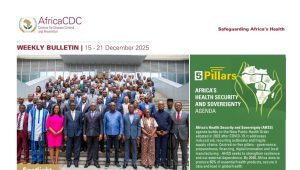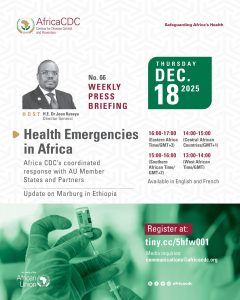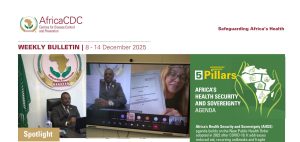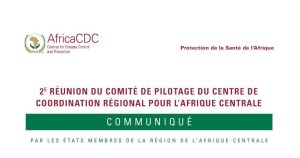It may have begun with the virus becoming active in the local mosquito population, prompted by heavy rains followed by warm weather — ideal conditions for the mosquitoes responsible for spreading the virus. Already present in the region, Rift Valley Fever (RVF) has now been confirmed in Senegal and Mauritania — two West African countries that share a 742 km border along the Senegal River.
Rift Valley Fever (RVF) is the latest zoonotic disease outbreak in Africa, invoking One Health interventions that align health responses across human, animal and environmental sectors. The outbreak was declared in Senegal on 21 September 2025.
As of 16 October, there were 171 confirmed human cases and 20 deaths, while 128 individuals have recovered. Contact tracing is ongoing, with 90 individuals listed, according to Dr Ngashi Ngongo, Principal Advisor to the Director-General of the Africa Centres for Disease Control and Prevention (Africa CDC).
“There are also ongoing outbreaks in animals,” he said. “Twenty-one cases have been reported — no deaths yet — but vaccination is already underway.”
To date, over 11,600 animals have been vaccinated in Senegal. Dr Merawi Tegegne, an epidemiologist and Head of the Surveillance and Disease Intelligence Division at Africa CDC, told a weekly press briefing that RVF has been endemic in northern Senegal since the 1980s.
He said RVF reflects a broader rise in mosquito-borne diseases such as dengue, driven by climate change and livestock movement. The virus circulates at a low level during non-outbreak seasons, but outbreaks are becoming more frequent.
“It is becoming more frequent these days — not only in Senegal, but across Eastern Africa and beyond. These diseases are closely linked with climate change and extreme weather events,” he said. “If you see torrential rain followed by floods, then sunny days, expect RVF in the coming days — these are favourable conditions for the vectors.”
The current outbreak in Senegal is concentrated in four hotspots across three regions: Richard Toll, Saint Louis, Dagana and Pete.
“When we look at the profile of those most affected (in Senegal), it’s mainly men,” said Dr Ngashi. “Males make up 55% of cases. And in terms of age group, those aged 15 to 35 account for 61% of all cases.”
Senegal’s Minister of Health and Public Hygiene, Ibrahima Sy, said the immediate priority is to strengthen medical infrastructure to ensure timely and effective treatment for patients, particularly those in critical condition, in order to save lives and contain the epidemic’s spread.
In Mauritania, an alarming rise in RVF infections has been recorded, with the Ministry of Livestock reporting 19 active outbreaks across 16 departments in eight regions. The country’s veterinary services launched an early detection operation in August, which initially confirmed two outbreaks. Since then, 334 samples have been analysed, with 90 testing positive for the virus.
Mauritania has experienced eight RVF epidemics in 38 years — from 1987 to 2025 — averaging one outbreak every four to five years. The most recent major epidemic was in 2022, with 47 confirmed cases and 23 deaths.
First identified in East Africa’s Rift Valley in 1931, this mosquito-borne illness, endemic in parts of Africa, affects both livestock and humans, and continues to cause major outbreaks across the region, impacting health, food security and livelihoods.
RVF is caused by a Ribonucleic acid (RNA) virus transmitted through bites from infected mosquitoes and exposure to infected animal fluids, especially during slaughtering, birthing or veterinary procedures. In East Africa, El Niño events drive outbreaks, while in West Africa, prolonged rains and alternating wet–dry spells are key factors. Common symptoms include fever, headache, muscle pain and fatigue. While most cases are mild, delayed treatment can lead to haemorrhagic complications, which may be fatal.
An RVF epidemic in 1987–88 killed more than 200 people in Senegal and Mauritania. Since then, Senegal has reported only minor outbreaks. The current resurgence coincides with other health emergencies across the continent: 23 countries are affected by cholera, and the situation is expected to worsen with the rainy season. The Democratic Republic of the Congo is battling Ebola in its Kasai province, mpox continues in 26 countries, and Lassa fever persists in four.
“We are dealing with multiple concurrent outbreaks that are putting a lot of pressure on resources,” said Dr Ngashi. “The vast majority are zoonotic spillovers.”
Africa CDC is collaborating with Ministries of Health, Agriculture, Environment and Wildlife to strengthen One Health coordination mechanisms, enabling data sharing and joint preparedness to prevent the transmission of diseases from animals to humans.
“Climate change and increased human–animal interaction are contributing to this trend,” said Dr Ngashi. “We need to anticipate, prevent and respond faster.”
He cited the strengthening of community-level surveillance and the enhancement of laboratory capacity as key priorities under the One Health framework.
RVF symptoms typically appear two to six days after infection and include flu-like fever, muscle and joint pain, headache and loss of appetite. While most people recover without treatment, a small percentage develop severe complications such as vision loss, meningoencephalitis or haemorrhagic fever.
There is currently no specific antiviral treatment or approved human vaccine. In 2024, 12 cases were reported across Mauritania, Kenya, Senegal and Uganda, with no deaths.







